More than 46 million homes in the U.S. are graced by the presence of a cat, showcasing the immense popularity of these feline companions. However, for individuals with allergies, the dream of cat ownership can often feel like a distant one, fraught with sneezes, itchy eyes, and endless discomfort. But take heart, aspiring cat lovers! While the notion of a completely hypoallergenic cat is a myth, certain breeds are known to produce fewer allergens, making them potentially wonderful additions to allergy-sensitive households.
Understanding Cat Allergies and Hypoallergenic Breeds
It’s a common misconception that cat allergies are triggered by cat hair itself. In reality, the culprit is a protein called Fel d 1, primarily found in cat saliva, skin glands, and urine. When cats groom themselves, they deposit saliva onto their fur, which then dries and becomes airborne as dander. This dander, carrying the Fel d 1 protein, is what triggers allergic reactions in sensitive individuals.
So, what makes some cat breeds “hypoallergenic”? These breeds typically produce less Fel d 1 protein than others, or they may have coat types that trap dander more effectively, leading to fewer allergens circulating in the environment. It’s crucial to understand that no cat is 100% hypoallergenic. However, choosing a breed known for lower allergen production can significantly reduce allergy symptoms and make cohabitation with a feline friend a much more comfortable experience.
Top Cat Breeds Recommended for Allergy Sufferers
If you’re seeking a feline companion but worried about allergies, exploring these breeds known for being better suited for allergy sufferers is a great starting point. Remember, individual reactions can vary, so spending time with a cat before bringing it home is always recommended.
1. Siberian
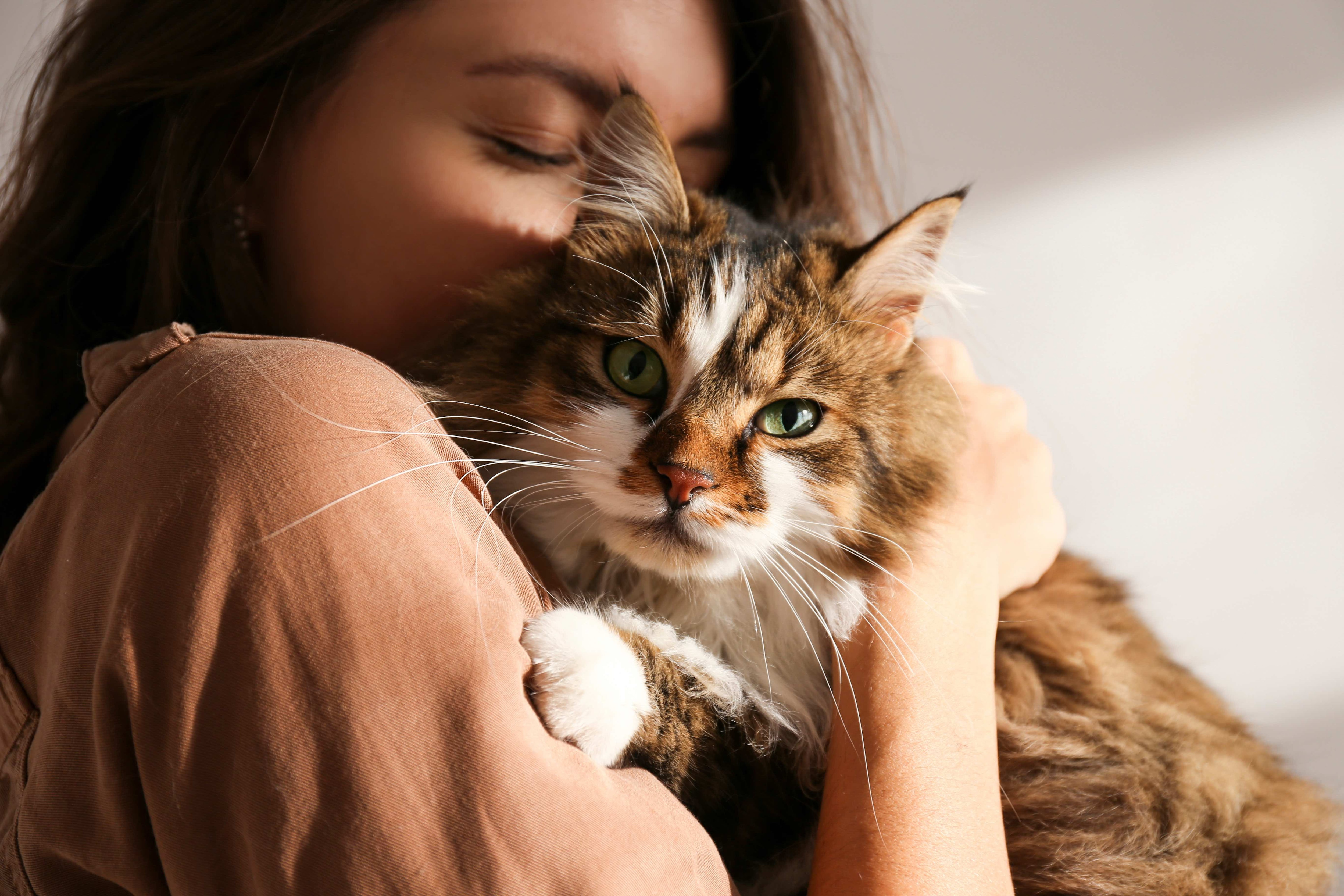 woman snuggling a longhair brown and white siberian cat
woman snuggling a longhair brown and white siberian cat
Photo credit: Adobe Stock/Evrymmnt
Siberian cats are often celebrated as one of the best cat breeds for allergies, and surprisingly so, given their luxurious, long, and thick coats. Despite their impressive fur, Siberians produce less of the Fel d 1 protein in their saliva compared to many other breeds. This lower production can translate to fewer allergy symptoms for sensitive individuals. Beyond their hypoallergenic qualities, Siberians are known for their affectionate and friendly nature, making them excellent family pets. Be prepared to dedicate time to regular grooming to keep their magnificent coat in top condition and minimize shedding.
2. Siamese
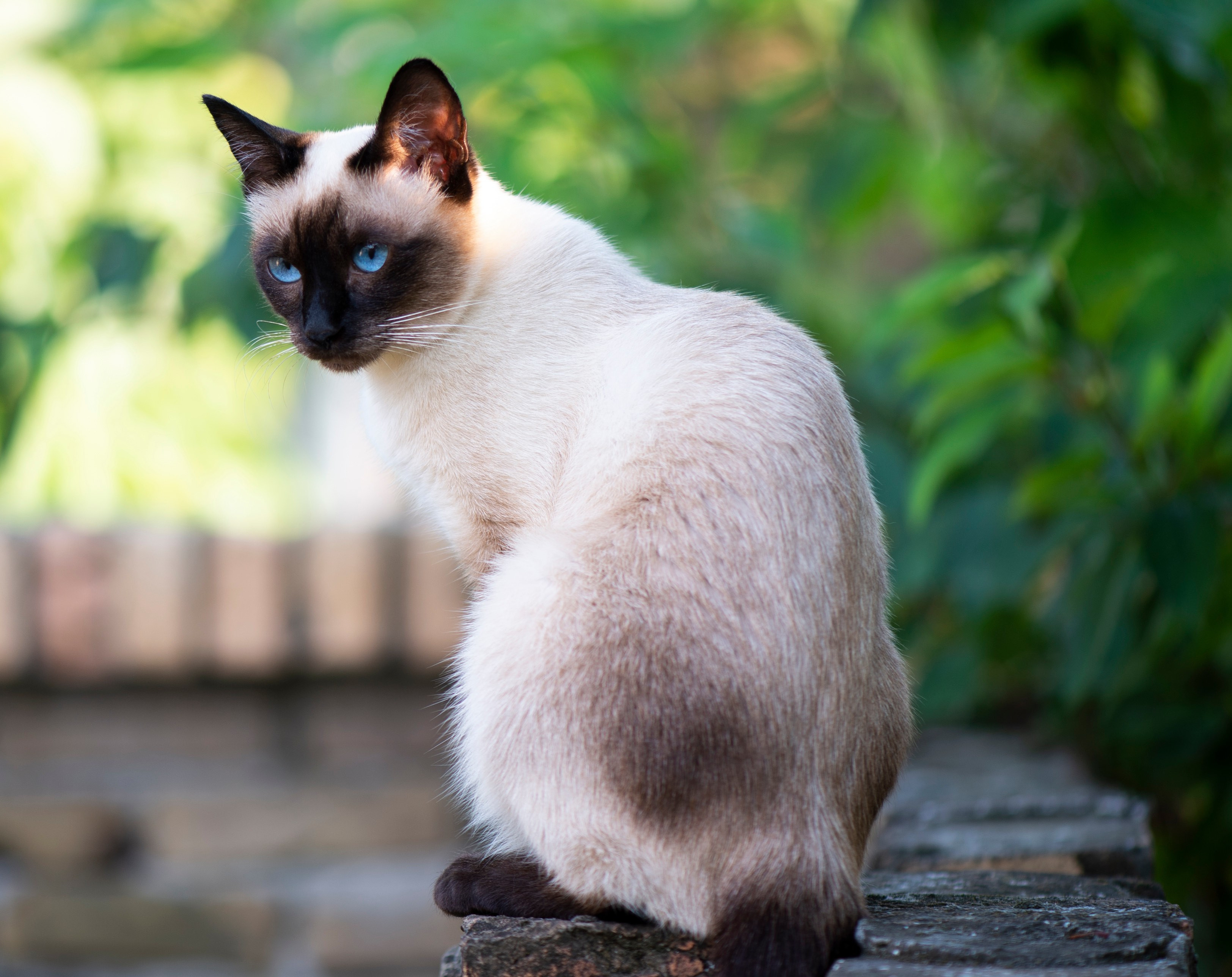 siamese cat sitting outside
siamese cat sitting outside
Photo credit: Adobe Stock/Vesna
The elegant Siamese cat is another breed frequently recommended for allergy sufferers. Their short, fine coat sheds minimally, which means less dander and fewer allergens released into your home. While no cat is entirely non-shedding, the Siamese’s low-shedding coat contributes to a lower allergen environment. Siamese cats are renowned for their distinctive vocalizations and deep bonds with their owners. They are intelligent, curious, and thrive on attention, making them wonderful companions for those who can provide them with plenty of interaction.
3. Bengal
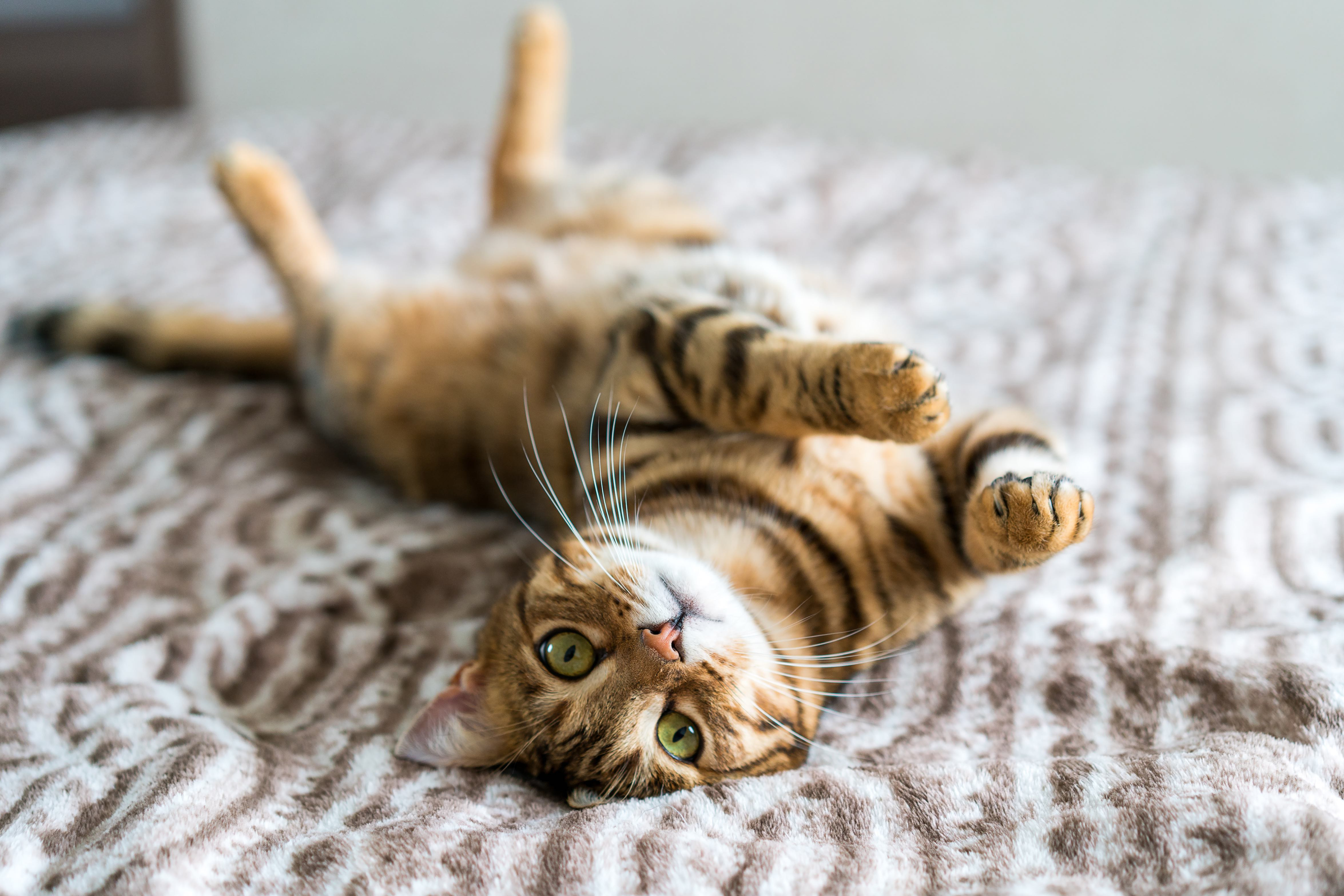 bengal cat lying on a bed on his back and showing his stomach
bengal cat lying on a bed on his back and showing his stomach
Photo credit: Adobe Stock/ingusk
Bengal cats, with their striking spotted coats reminiscent of their wild Asian Leopard Cat ancestors, are not only visually captivating but also considered a hypoallergenic breed. Their short, pelt-like coat sheds very little, reducing the amount of allergen-carrying dander in your home. Bengals are highly energetic and intelligent cats, known for their playful nature and adventurous spirit. They require an active household and owners who can provide ample playtime and mental stimulation. It’s worth noting that some regions may have specific regulations regarding Bengal ownership due to their wild ancestry, so it’s essential to check local laws.
4. Russian Blue
 russian blue cat headbutting a man
russian blue cat headbutting a man
Photo credit: iStock/Drazen_Hypoallergenic
Russian Blue cats are admired for their plush, silvery-blue coats and gentle, reserved personalities. They are often listed among hypoallergenic breeds due to their dense yet short coat that traps dander effectively. While they do shed, the amount is relatively low compared to many other breeds. Russian Blues are known for their affectionate nature with their families but can be initially shy around strangers. They appreciate a calm environment and are often described as quiet and well-behaved companions. Regular grooming will help manage their shedding and keep their coat healthy.
5. Sphynx
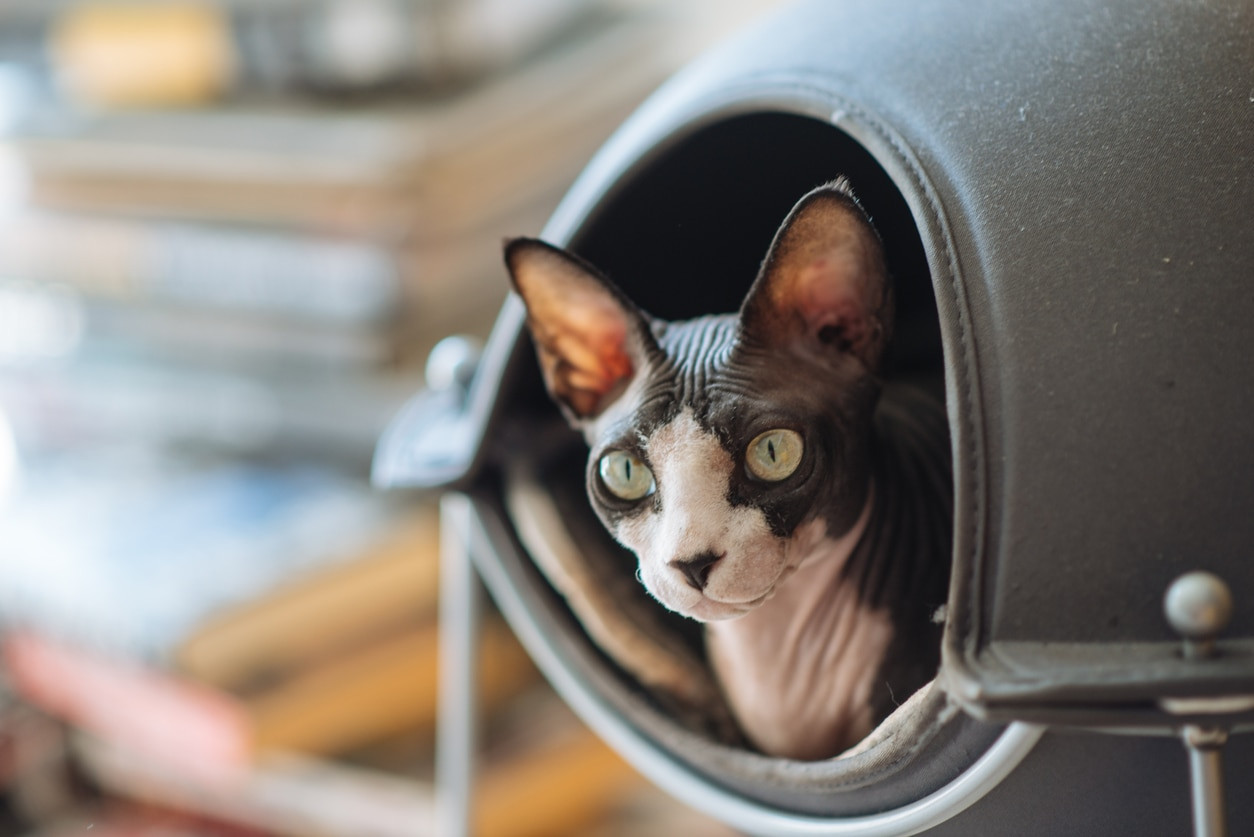 black and pink sphynx cat looking out of a covered cat bed
black and pink sphynx cat looking out of a covered cat bed
Photo credit: iStock/Drazen_
The Sphynx cat, instantly recognizable for its lack of fur, is perhaps the most intuitively “hypoallergenic” breed. While they aren’t truly hairless – most have a fine layer of downy fuzz – their lack of a traditional coat significantly reduces the amount of hair and dander they shed. However, it’s important to remember that Sphynx cats still produce allergens in their saliva and skin secretions. Sphynx cats are exceptionally social and affectionate, often described as “velcro cats” due to their desire for constant human contact. Their unique skin requires regular bathing to remove oil buildup and maintain skin health.
6. Devon Rex
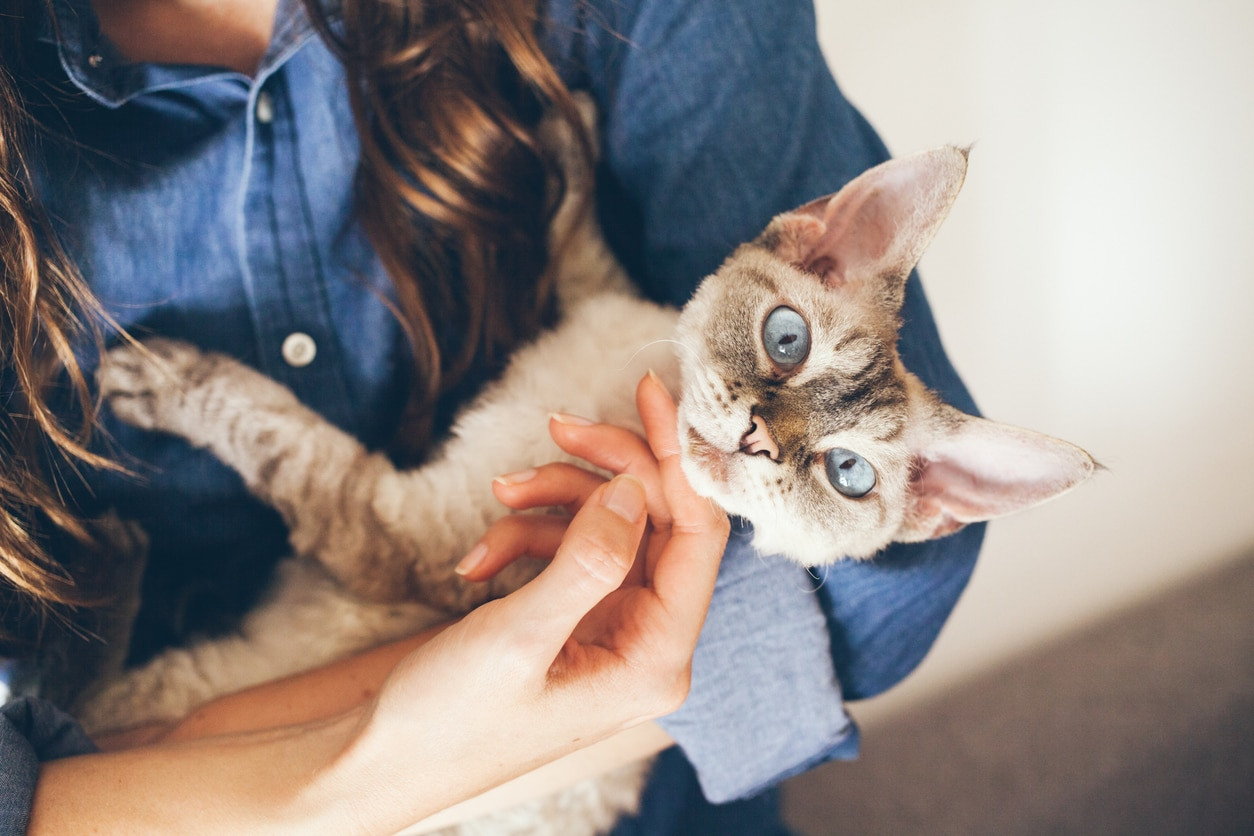 woman holding a devon rex cat like a baby
woman holding a devon rex cat like a baby
Photo credit: iStock/insonnia
Devon Rex cats are characterized by their large ears, wavy, soft coat, and impish expressions. Their unique coat, which is shorter and wavier than that of the Cornish Rex, sheds minimally, making them a good choice for allergy sufferers. Devon Rex cats are known for their playful and mischievous personalities. They are highly intelligent and active cats who enjoy interactive play and attention from their families. They can be quite demanding of attention and may not be suitable for households where they are left alone for extended periods.
7. Cornish Rex
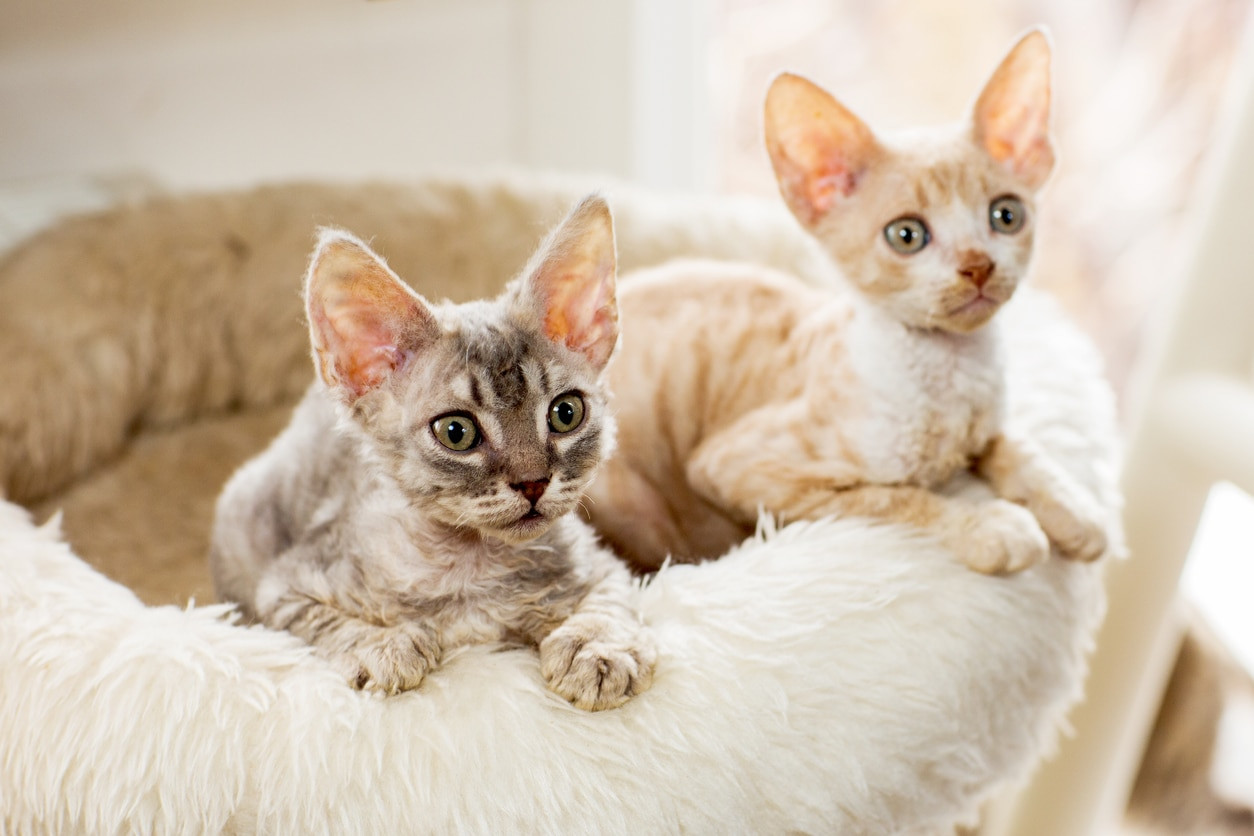 two cornish rex kittens in a cat bed
two cornish rex kittens in a cat bed
Photo credit: iStock/Sicha69
Similar to the Devon Rex, the Cornish Rex boasts a distinctive curly coat that lies close to the body. This fine, wavy fur sheds very little, contributing to a lower allergen environment. Cornish Rex cats are known for their affectionate and outgoing personalities. They are often described as kitten-like throughout their lives, maintaining a playful and energetic demeanor. They thrive on human interaction and can be excellent companions for children and other pets. Their fine coat requires minimal grooming but they appreciate regular attention.
8. Javanese
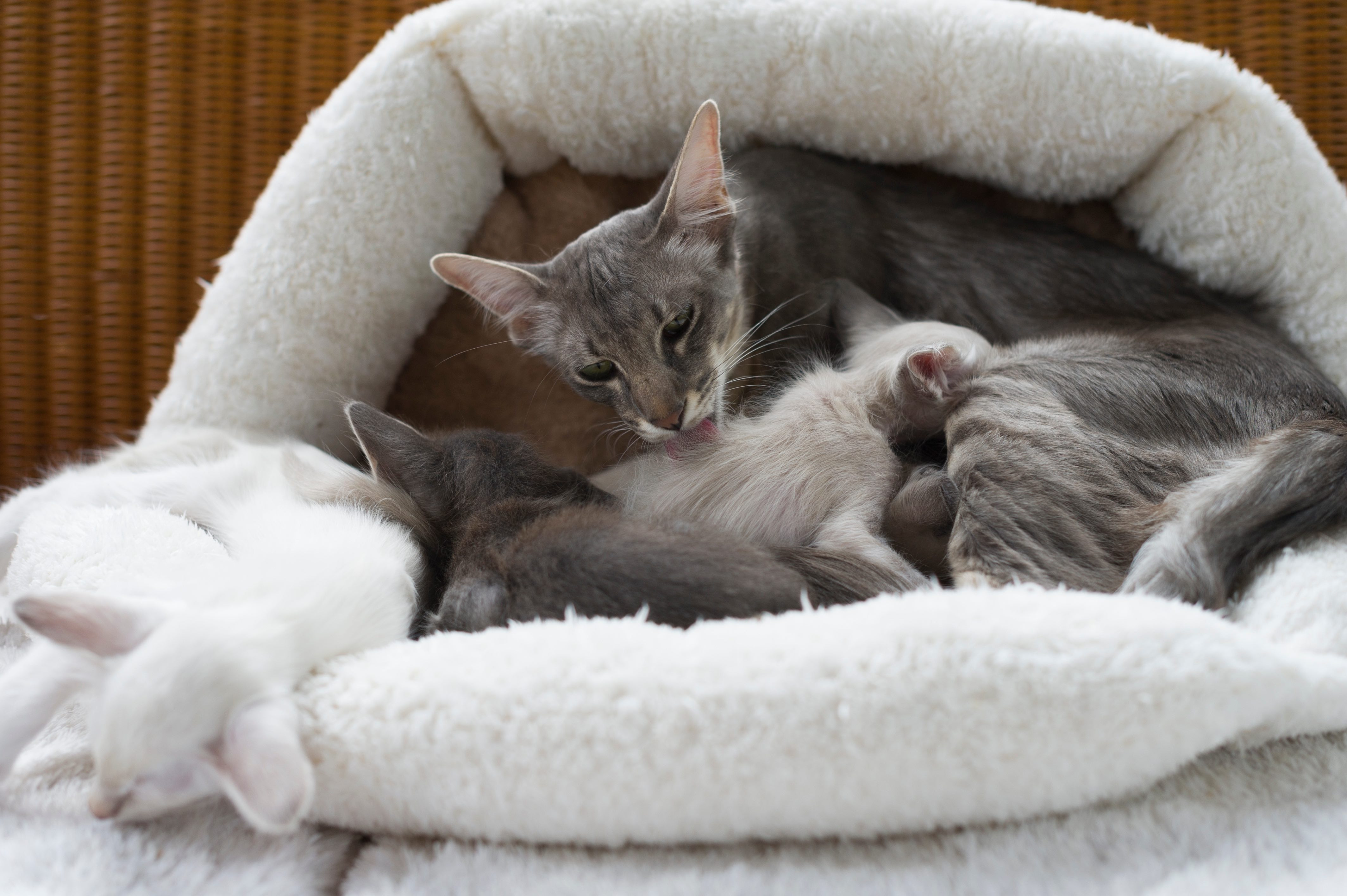 gray javanese cat mom grooming her kittens
gray javanese cat mom grooming her kittens
Photo credit: Adobe Stock/Heidi Bollich
Javanese cats, closely related to Siamese and Balinese breeds, possess a silky, medium-length single coat. Despite their longer hair compared to some short-haired breeds, Javanese cats are considered hypoallergenic due to their lower shedding tendencies and potentially lower Fel d 1 production. Javanese cats are intelligent, vocal, and highly people-oriented. They crave companionship and can be quite demanding of attention. They are playful and active cats who enjoy interactive games and exploring their surroundings. Regular grooming is needed to prevent mats and tangles in their silky coat.
9. Balinese
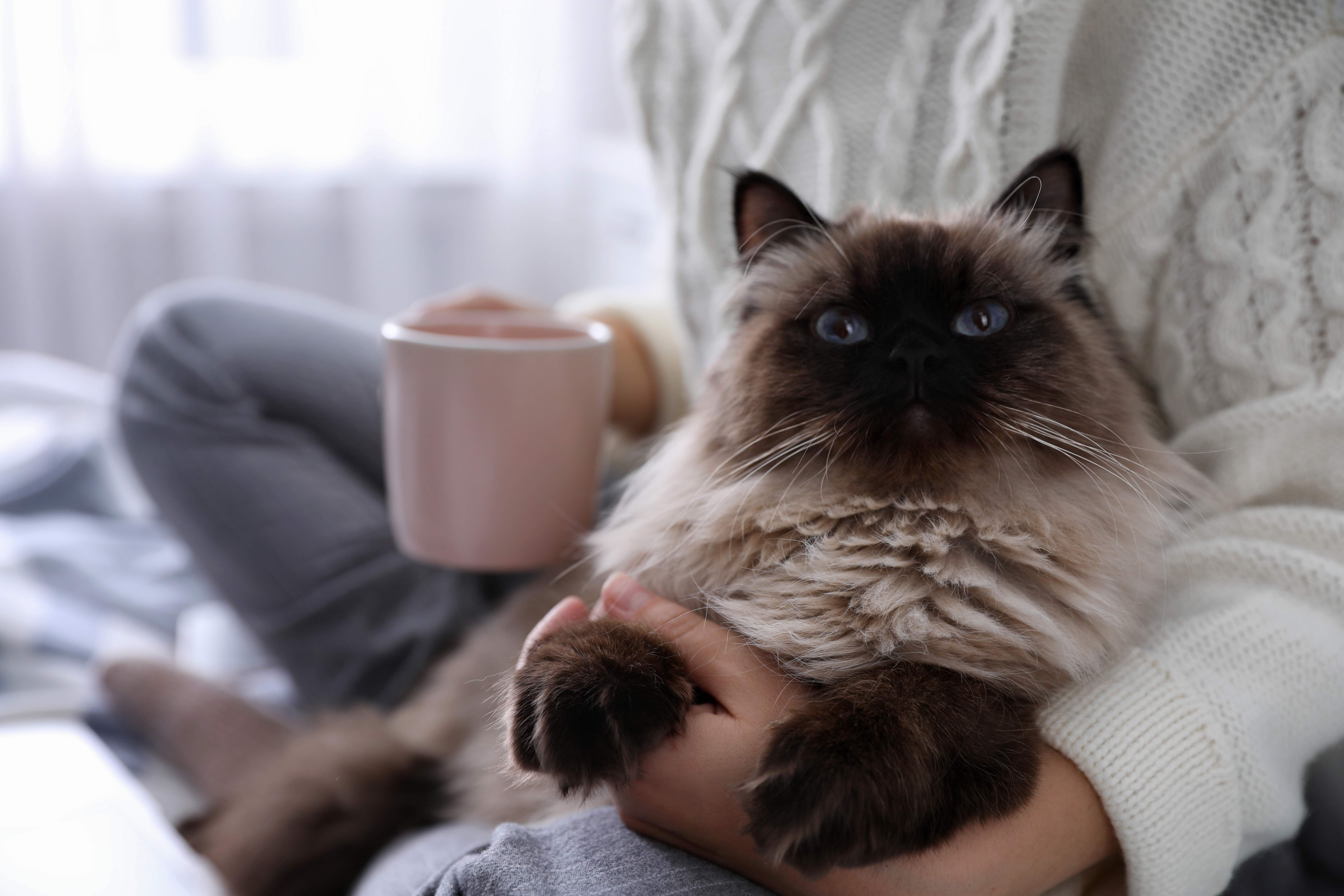 longhaired balinese cat snuggling with a woman
longhaired balinese cat snuggling with a woman
Photo credit: Adobe Stock/New Africa
The Balinese cat, often referred to as the “longhaired Siamese,” shares the Siamese’s elegant appearance and vocal nature but with a flowing, plumed tail and a slightly longer coat. Despite their luxurious appearance, Balinese cats are considered hypoallergenic, believed to produce less Fel d 1 protein, similar to their Siamese relatives. Balinese cats are intelligent, affectionate, and playful. They are known for their strong bonds with their families and can be trained to perform tricks. Their moderate coat requires regular grooming to prevent tangles and maintain its silky texture.
10. Oriental Shorthair
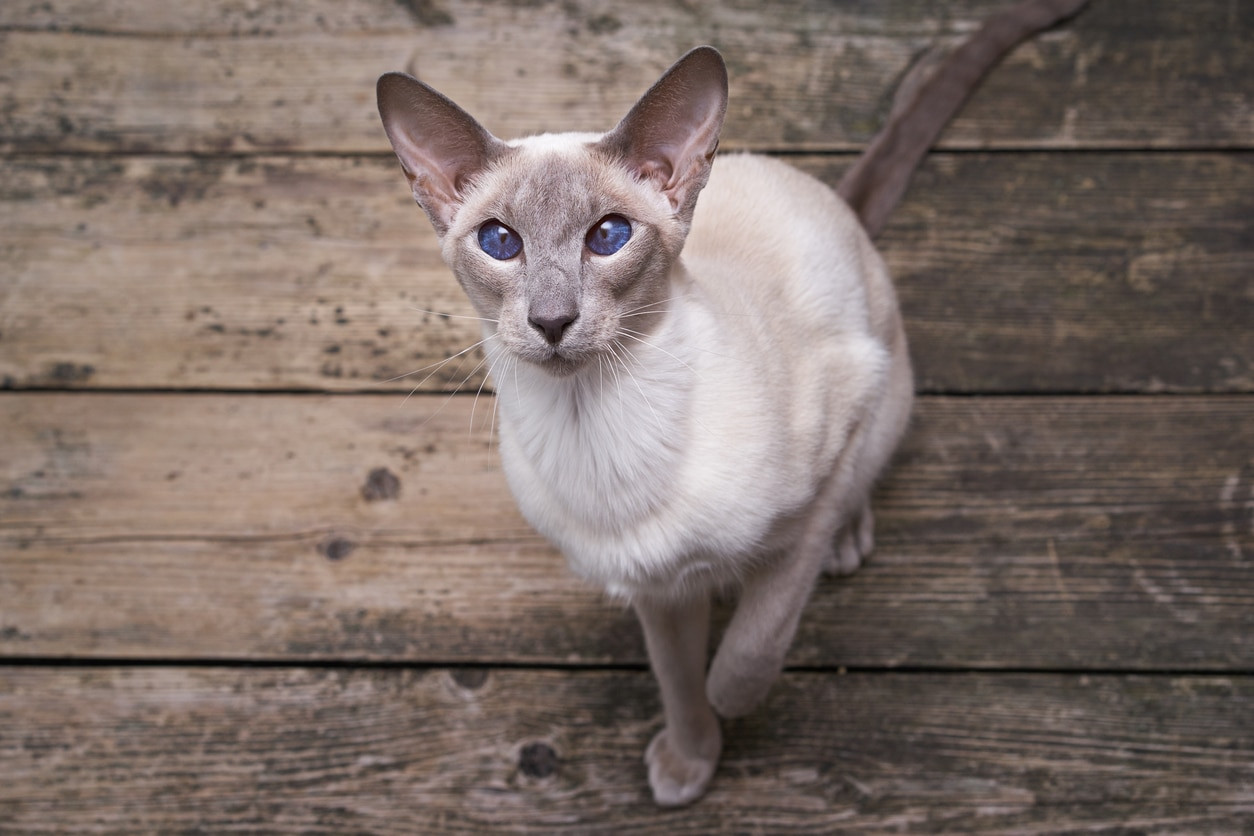 gray and white oriental shorthair cat looking up at the camera
gray and white oriental shorthair cat looking up at the camera
Photo credit: iStock/Leschenko
Oriental Shorthair cats are known for their striking, slender bodies, large ears, and almond-shaped eyes. Their short, fine coat lies close to the body and requires minimal grooming, resulting in less shedding and fewer allergens. Oriental Shorthairs are intelligent, curious, and highly active cats. They are known for their playful and inquisitive nature, often getting into mischief. They are also very vocal and enjoy “conversing” with their owners.
11. Burmese
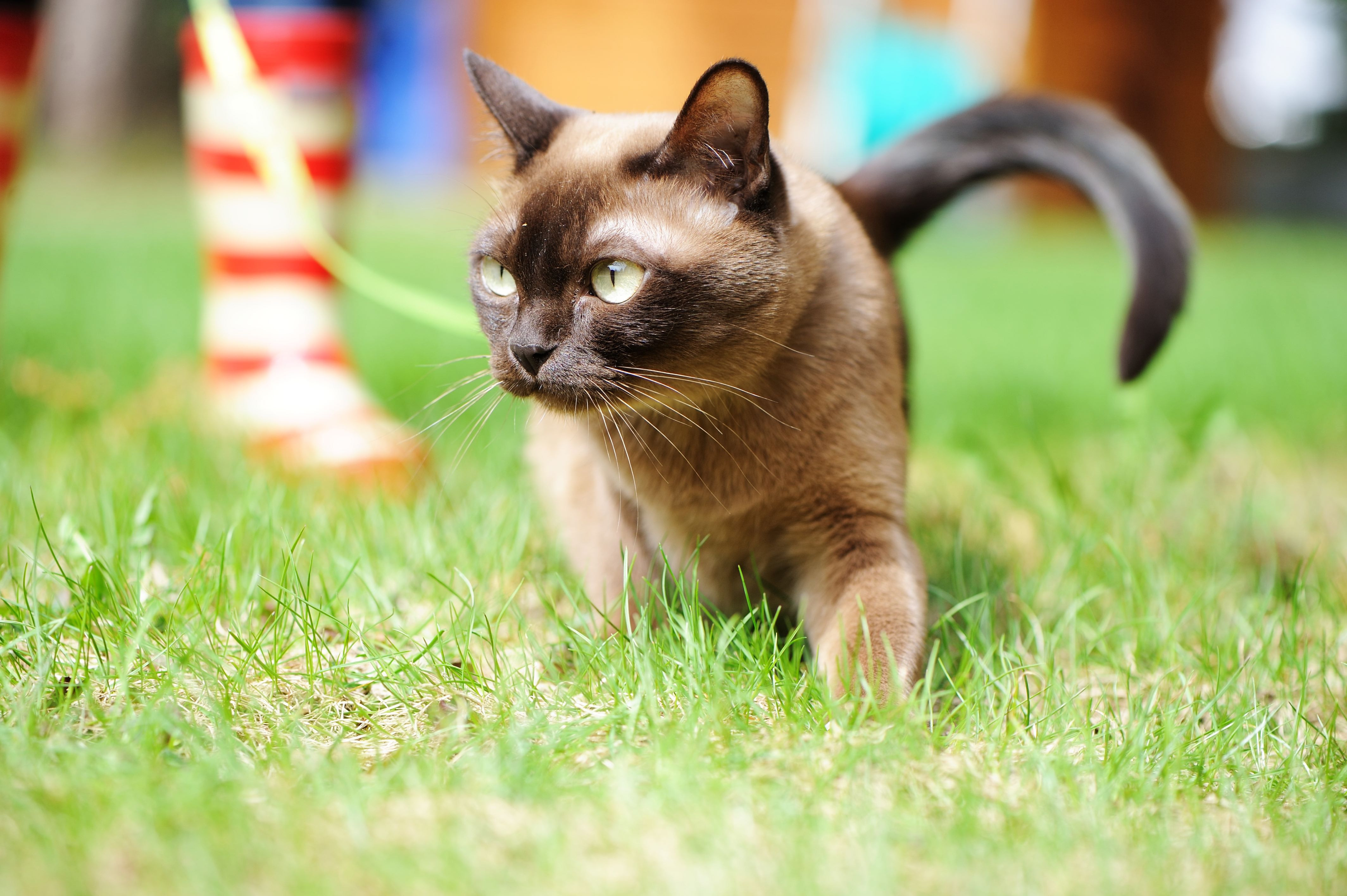 burmese cat walking on a leash and harness outside
burmese cat walking on a leash and harness outside
Photo credit: Adobe Stock/Alinute
Burmese cats possess a sleek, satin-like short coat that is low-shedding and requires minimal grooming. This low-shedding quality contributes to their reputation as a hypoallergenic breed. Burmese cats are known for their affectionate and people-oriented personalities. They are playful and energetic, enjoying interactive games and attention from their families. They are also intelligent and can be trained. Their short coat is easy to care for, needing only occasional brushing.
12. Tonkinese
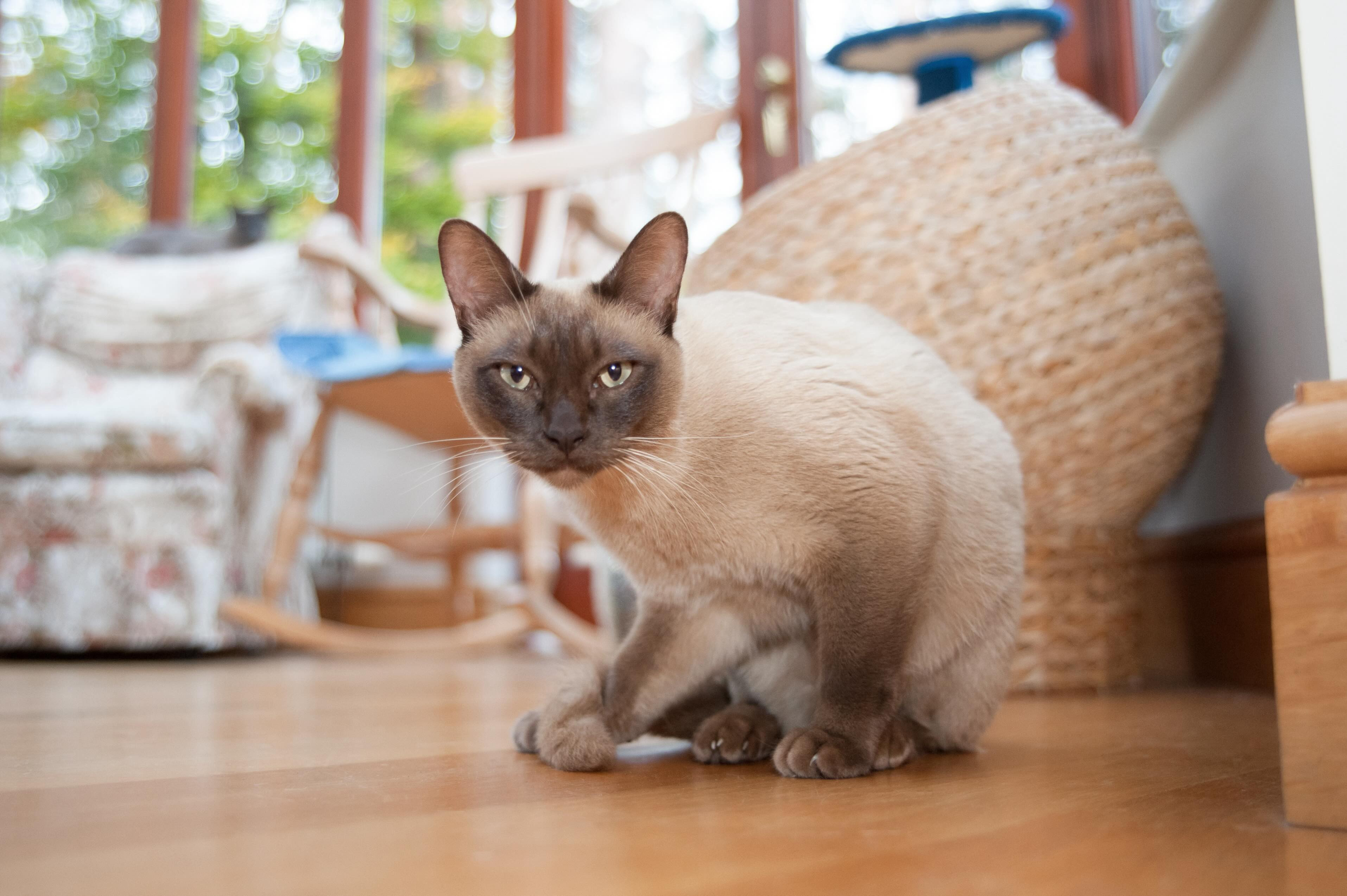 champagne tonkinese cat sitting on the floor and looking straight at the camera
champagne tonkinese cat sitting on the floor and looking straight at the camera
Photo credit: Adobe Stock/Steve Mann
The Tonkinese cat is a hybrid breed resulting from crossing Siamese and Burmese cats, inheriting desirable traits from both. They have a short, fine coat that is low-shedding, making them a potentially good choice for allergy sufferers. Tonkinese cats are known for their lively and playful personalities. They are social, affectionate, and enjoy being the center of attention. They are also intelligent and vocal, often engaging in “conversations” with their owners. Their low-maintenance coat requires minimal grooming.
Tips for Creating an Allergy-Friendly Home with Cats
Choosing a breed known for being better for allergies is just the first step. Managing allergies effectively also involves creating a home environment that minimizes allergen exposure.
Conduct In-Person “Allergy Tests”
Before committing to any cat, especially one of the breeds listed as hypoallergenic, spend quality time with cats of that breed. Visit breeders, shelters, or foster homes to interact with them directly. This will help you gauge your allergic reaction and determine if a particular breed is truly a better fit for you.
Consult with an Allergy Specialist
If you have significant allergies, consulting an allergist is a wise step. They can perform allergy testing to pinpoint the severity of your cat allergies and recommend strategies to manage them, potentially including medication or immunotherapy.
Implement Rigorous Home Cleaning
Even with a low-allergen cat, regular cleaning is crucial. Vacuum frequently, ideally with a HEPA filter vacuum, to remove cat dander from carpets, rugs, and upholstery. Dust regularly and consider using air purifiers with HEPA filters to reduce airborne allergens. Wash bedding, curtains, and pet beds frequently.
Groom Your Cat Regularly
Regular grooming, even for short-haired cats, can significantly reduce loose hair and dander. Brushing your cat several times a week, ideally outdoors or in a well-ventilated area, helps remove loose fur before it spreads around your home. Some allergy sufferers also find that bathing their cat occasionally (as recommended by a vet) can help reduce surface allergens.
Consider Allergen-Reducing Cat Food
Innovative cat food options, such as Purina Pro Plan LIVECLEAR, are formulated to reduce the active Fel d 1 allergen in cat saliva. This dietary approach can be a helpful additional strategy to minimize allergen exposure in your home. Discuss with your veterinarian whether this type of food is appropriate for your cat.
FAQs About Cats and Allergies
Are there any truly non-shedding cats?
No cat is entirely non-shedding. Even hairless breeds like the Sphynx still produce dander and skin oils. However, breeds like the Sphynx and Rex cats shed significantly less hair than many other breeds, which can reduce allergen dispersal.
Can a cat be 100% hypoallergenic?
Unfortunately, the answer is no. All cats produce Fel d 1 protein, the primary cat allergen. While some breeds produce less or have coat types that minimize allergen release, no breed is completely allergen-free.
Beyond breed choice, what else can help with cat allergies?
Managing cat allergies is multifaceted. In addition to breed selection and home cleaning, consider:
- Designated Cat-Free Zones: Make bedrooms or other key areas of your home cat-free zones to reduce allergen exposure during sleep and rest.
- Medications: Antihistamines, nasal corticosteroids, and other allergy medications can effectively manage allergy symptoms.
- Allergy Immunotherapy (Allergy Shots): For more severe allergies, immunotherapy can help desensitize your immune system to cat allergens over time.
Conclusion: Welcoming a Feline Friend into Your Allergy-Sensitive Home
While the quest for a truly hypoallergenic cat remains elusive, the good news is that cat allergies don’t necessarily preclude cat ownership. By choosing a breed known for lower allergen production, implementing proactive home management strategies, and potentially consulting with allergy specialists and veterinarians, many allergy sufferers can successfully and happily share their lives with feline companions. Remember, individual reactions vary, and careful research and preparation are key to finding the best cat breed for your unique situation and creating a harmonious, sneeze-free home for both you and your new furry family member.
